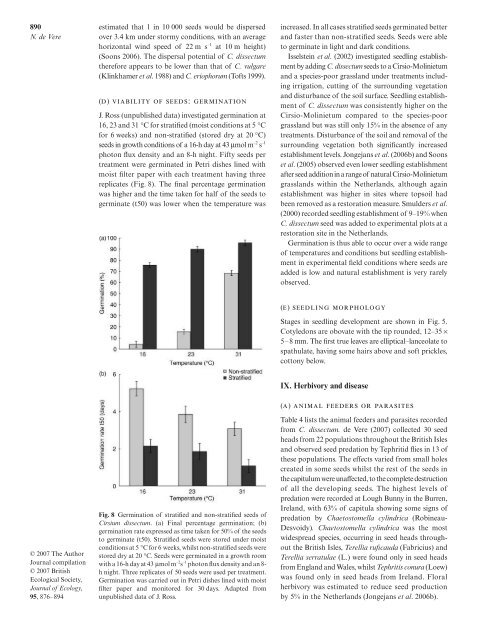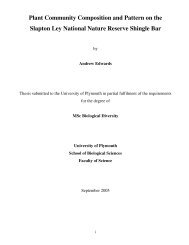de Vere 2007 Biol Flora C. dissectum.pdf - The Whitley Wildlife ...
de Vere 2007 Biol Flora C. dissectum.pdf - The Whitley Wildlife ...
de Vere 2007 Biol Flora C. dissectum.pdf - The Whitley Wildlife ...
- No tags were found...
You also want an ePaper? Increase the reach of your titles
YUMPU automatically turns print PDFs into web optimized ePapers that Google loves.
890N. <strong>de</strong> <strong>Vere</strong>estimated that 1 in 10 000 seeds would be dispersedover 3.4 km un<strong>de</strong>r stormy conditions, with an averagehorizontal wind speed of 22 m s –1 at 10 m height)(Soons 2006). <strong>The</strong> dispersal potential of C. <strong>dissectum</strong>therefore appears to be lower than that of C. vulgare(Klinkhamer et al. 1988) and C. eriophorum (Tofts 1999).(D) VIABILITY OF SEEDS: GERMINATIONJ. Ross (unpublished data) investigated germination at16, 23 and 31 °C for stratified (moist conditions at 5 °Cfor 6 weeks) and non-stratified (stored dry at 20 °C)seeds in growth conditions of a 16-h day at 43 µmol m –2 s –1photon flux <strong>de</strong>nsity and an 8-h night. Fifty seeds pertreatment were germinated in Petri dishes lined withmoist filter paper with each treatment having threereplicates (Fig. 8). <strong>The</strong> final percentage germinationwas higher and the time taken for half of the seeds togerminate (t50) was lower when the temperature wasincreased. In all cases stratified seeds germinated betterand faster than non-stratified seeds. Seeds were ableto germinate in light and dark conditions.Isselstein et al. (2002) investigated seedling establishmentby adding C. <strong>dissectum</strong> seeds to a Cirsio-Molinietumand a species-poor grassland un<strong>de</strong>r treatments includingirrigation, cutting of the surrounding vegetationand disturbance of the soil surface. Seedling establishmentof C. <strong>dissectum</strong> was consistently higher on theCirsio-Molinietum compared to the species-poorgrassland but was still only 15% in the absence of anytreatments. Disturbance of the soil and removal of thesurrounding vegetation both significantly increase<strong>de</strong>stablishment levels. Jongejans et al. (2006b) and Soonset al. (2005) observed even lower seedling establishmentafter seed addition in a range of natural Cirsio-Molinietumgrasslands within the Netherlands, although againestablishment was higher in sites where topsoil hadbeen removed as a restoration measure. Smul<strong>de</strong>rs et al.(2000) recor<strong>de</strong>d seedling establishment of 9–19% whenC. <strong>dissectum</strong> seed was ad<strong>de</strong>d to experimental plots at arestoration site in the Netherlands.Germination is thus able to occur over a wi<strong>de</strong> rangeof temperatures and conditions but seedling establishmentin experimental field conditions where seeds aread<strong>de</strong>d is low and natural establishment is very rarelyobserved.(E) SEEDLING MORPHOLOGYStages in seedling <strong>de</strong>velopment are shown in Fig. 5.Cotyledons are obovate with the tip roun<strong>de</strong>d, 12–35 ×5–8 mm. <strong>The</strong> first true leaves are elliptical–lanceolate tospathulate, having some hairs above and soft prickles,cottony below.© <strong>2007</strong> <strong>The</strong> AuthorJournal compilation© <strong>2007</strong> BritishEcological Society,Journal of Ecology,95, 876–894Fig. 8 Germination of stratified and non-stratified seeds ofCirsium <strong>dissectum</strong>. (a) Final percentage germination; (b)germination rate expressed as time taken for 50% of the seedsto germinate (t50). Stratified seeds were stored un<strong>de</strong>r moistconditions at 5 °C for 6 weeks, whilst non-stratified seeds werestored dry at 20 °C. Seeds were germinated in a growth roomwith a 16-h day at 43 µmol m –2 s –1 photon flux <strong>de</strong>nsity and an 8-h night. Three replicates of 50 seeds were used per treatment.Germination was carried out in Petri dishes lined with moistfilter paper and monitored for 30 days. Adapted fromunpublished data of J. Ross.IX. Herbivory and disease(A) ANIMAL FEEDERS OR PARASITESTable 4 lists the animal fee<strong>de</strong>rs and parasites recor<strong>de</strong>dfrom C. <strong>dissectum</strong>. <strong>de</strong> <strong>Vere</strong> (<strong>2007</strong>) collected 30 seedheads from 22 populations throughout the British Islesand observed seed predation by Tephritid flies in 13 ofthese populations. <strong>The</strong> effects varied from small holescreated in some seeds whilst the rest of the seeds inthe capitulum were unaffected, to the complete <strong>de</strong>structionof all the <strong>de</strong>veloping seeds. <strong>The</strong> highest levels ofpredation were recor<strong>de</strong>d at Lough Bunny in the Burren,Ireland, with 63% of capitula showing some signs ofpredation by Chaetostomella cylindrica (Robineau-Desvoidy). Chaetostomella cylindrica was the mostwi<strong>de</strong>spread species, occurring in seed heads throughoutthe British Isles, Terellia ruficauda (Fabricius) andTerellia serratulae (L.) were found only in seed headsfrom England and Wales, whilst Tephritis conura (Loew)was found only in seed heads from Ireland. <strong>Flora</strong>lherbivory was estimated to reduce seed productionby 5% in the Netherlands (Jongejans et al. 2006b).




